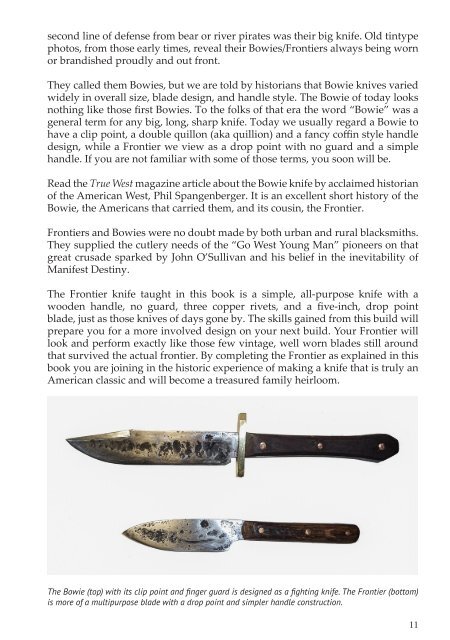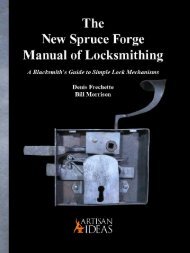FORGED: Making a Knife with Traditional Blacksmith Skills
This book will teach you to hand build a knife using the traditional method of blacksmiths of old — FORGING. Traditional forging of a knife blade is a process which uses the ancient techniques of moving hot steel with hammer and anvil alone into a knife-form that is ready for filing, heat treating and sharpening with no or very minimal electric grinding. This book also teaches traditional fit-and-finish skills using only hand tools. It explains an ancient riveted full-tang handle construction system that surpasses modern methods. In the author's words; "In my early blacksmithing years, I was lucky to get to know some old smiths who wrangled hot iron every day just to make a living. They unselfishly taught me traditional blacksmithing skills and knife forging methods. Every time I use those skills and methods, I honor their friendships, and by teaching you, the reader, we keep alive the memory of those old-time iron pounders." Hardcover, 132 pages, 150 photos and illustrations, $29.95.
This book will teach you to hand build a knife using the traditional method of blacksmiths of old — FORGING.
Traditional forging of a knife blade is a process which uses the ancient techniques of moving hot steel with hammer and anvil alone into a knife-form that is ready for filing, heat treating and sharpening with no or very minimal electric grinding.
This book also teaches traditional fit-and-finish skills using only hand tools. It explains an ancient riveted full-tang handle construction system that surpasses modern methods.
In the author's words; "In my early blacksmithing years, I was lucky to get to know some old smiths who wrangled hot iron every day just to make a living. They unselfishly taught me traditional blacksmithing skills and knife forging methods. Every time I use those skills and methods, I honor their friendships, and by teaching you, the reader, we keep alive the memory of those old-time iron pounders."
Hardcover, 132 pages, 150 photos and illustrations, $29.95.
You also want an ePaper? Increase the reach of your titles
YUMPU automatically turns print PDFs into web optimized ePapers that Google loves.
second line of defense from bear or river pirates was their big knife. Old tintype<br />
photos, from those early times, reveal their Bowies/Frontiers always being worn<br />
or brandished proudly and out front.<br />
They called them Bowies, but we are told by historians that Bowie knives varied<br />
widely in overall size, blade design, and handle style. The Bowie of today looks<br />
nothing like those first Bowies. To the folks of that era the word “Bowie” was a<br />
general term for any big, long, sharp knife. Today we usually regard a Bowie to<br />
have a clip point, a double quillon (aka quillion) and a fancy coffin style handle<br />
design, while a Frontier we view as a drop point <strong>with</strong> no guard and a simple<br />
handle. If you are not familiar <strong>with</strong> some of those terms, you soon will be.<br />
Read the True West magazine article about the Bowie knife by acclaimed historian<br />
of the American West, Phil Spangenberger. It is an excellent short history of the<br />
Bowie, the Americans that carried them, and its cousin, the Frontier.<br />
Frontiers and Bowies were no doubt made by both urban and rural blacksmiths.<br />
They supplied the cutlery needs of the “Go West Young Man” pioneers on that<br />
great crusade sparked by John O’Sullivan and his belief in the inevitability of<br />
Manifest Destiny.<br />
The Frontier knife taught in this book is a simple, all-purpose knife <strong>with</strong> a<br />
wooden handle, no guard, three copper rivets, and a five-inch, drop point<br />
blade, just as those knives of days gone by. The skills gained from this build will<br />
prepare you for a more involved design on your next build. Your Frontier will<br />
look and perform exactly like those few vintage, well worn blades still around<br />
that survived the actual frontier. By completing the Frontier as explained in this<br />
book you are joining in the historic experience of making a knife that is truly an<br />
American classic and will become a treasured family heirloom.<br />
The Bowie (top) <strong>with</strong> its clip point and finger guard is designed as a fighting knife. The Frontier (bottom)<br />
is more of a multipurpose blade <strong>with</strong> a drop point and simpler handle construction.<br />
11










